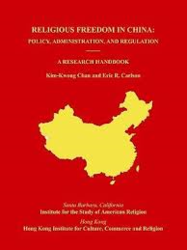
Chan, Kim-kwong, and Carlson, Eric R. Religious Freedom in China: Policy, Administration, and Regulation; a Research Handbook. Santa Barbara, California: Institute for the Study of American Religion, and Hong Kong: Hong Kong Institute for Culture, Commerce, and Religion, 2005. ISBN-10: 0915051036; ISBN-13: 978-0915051038; 108 pages, paperback, $9.45 at Amazon.com.
To some extent, Western perceptions of the religious situation in China are stuck in a time warp, based on policies and realties that existed during the Cultural Revolution, when Mao closed all places of worship and tried to extinguish religion altogether. While there is in the United States and elsewhere in the West quite a deep understanding and appreciation for the dramatic economic changes that have taken place in China over the past twenty-five years, there is less understanding of the ways in which laws and policies governing religion have also undergone significant transformation.
Writing in 2005, two of the contributors to this volume noted the gap between perception and reality in understanding the state of freedom of religion in China. Eight years later the same statement could still be made with quite some accuracy. The Olympic Games in 2008 and China’s continued economic integration with the rest of the world have done much to shine light on the economic and social realities of China. Nonetheless, in discussing matters of religion, outside observers often take as their default position the assumption that the Chinese state is actively seeking to restrict all religious activities.
As pointed out in this volume, this outdated perception is due in large part to the paucity of reliable information about religious policy and its implementation in China. In the absence of such information, those seeking to understand the situation must rely on anecdotal evidence, which, devoid of context, can create widely differing perceptions. Hence the value of this book which combines an analysis of the mechanisms by which religion is regulated in China with an extensive list of religious policy documents, both public and internal (neibu), issued by government organs at various levels.
In addition to the difficulty of piecing together from conflicting reports a coherent picture of China’s religious policy and its implementation, another obstacle to making sense of the situation is the fact that policy flows largely from the pronouncements of Party officials and from administrative regulations emanating from government organs concerned with religion. Despite China’s move toward “rule of law,” precious little legislation on religion exists. Outside observers or foreigners living in China who want to see in black and white what is or is not allowed are understandably frustrated by this lack of clarity. The first of three major sections in this volume analyzes the respective of roles of Party and government actors in determining policy. These include the Party’s United Front Work Department, responsible for formulating and implementing policy, and the State Administration for Religious Affairs, which has the power to issue binding regulations on religious groups and activities, as well as their corresponding organizations at various levels. This section also looks at the roles of other branches of government such as the various police organs, the judiciary and the military. Brief mention is made of the official organizations representing China’s five recognized religions (Protestant Christianity, Catholicism, Buddhism, Taoism, and Islam).
Of particular interest in this section is its coverage of significant portions of society that are effectively exempt from the religion clause in China’s constitution. Individuals in these spheres do not enjoy freedom of belief nor can they expect to have access to religious facilities or activities. The Communist Party itself would be the prime example here, as Party members are avowed atheists. Others in this category include those in prisons or labor camps, those serving in the military or in China’s security apparatus, those employed in some large state-run industries which have jurisdiction over the communities where they work, and those living in minority areas where a particular religion is accepted as the dominant belief system in the region. Looking at the various administrative divisions in China, this section also makes the point that, even for ordinary Chinese, implementation of policy can vary widely from place to place, depending upon local politics and the sophistication (or lack thereof) and personal agendas of officials. Overall, the authors point out, China’s religious policy tilts toward keeping religion from interfering in civil and government affairs as opposed to protecting religion from government interference (which is assumed to be the role of religious policy, to the extent it even exists, in the Western world).
Section Two briefly traces the development of religious policy from the founding of the PRC up through the mid 2000s. Three common themes emerge: the freedom both to believe and not to believe in religion; the state’s “neutral” stance in neither promoting nor suppressing any particular religion; and the autonomy of religious affairs in China, which places particular strain on religious groups, such as the Catholic Church, that have international ties. These themes are set forth in Document 19, issued in 1982, which still stands as the authoritative guiding Party document on religion today. In the 1990s, policy was clarified, but not significantly changed, through the issuing of State Council decrees 144 and 145, which dealt with, respectively, religious activities of foreigners and the management of religious venues, and numerous local regulations. Policy statements following China’s accession to the World Trade Organization recognized both the role of religion in “cushioning” the effects of social change brought about by China’s continued opening to the outside world as well as the need to block the efforts of potentially hostile foreign religious groups. Subsequent policy pronouncements, such as State Council decree 426, issued in 2004, have been aimed at further standardizing the administration of religious affairs on a nationwide basis.
In Section Three the authors list all published religious regulations through the year 2004. These include national and regional regulations, plus guiding documents by various government entities, internal documents, articles in Chinese periodicals, Party and government publications on religion and public security documents. These are followed by lists of English- and Chinese-language secondary sources and relevant web sites. All of the references to regional regulations include links to web sites where the documents may be accessed.
As a research handbook, this book is particularly useful in that it provides in one place a guide to accessing disparate documents that follow a common theme but come from a wide variety of sources. The authors have done a great service in tracking down and cataloguing these many documents. The overviews of policy development and of the various government organs involved in setting and enforcing policy bring clarity to the generally opaque process by which religion is governed in China. While these overviews cannot explore this process in detail, the many documents referenced in section three of the book offer ample choices for readers who wish to go deeper.
The religious situation in China is quite fluid. Although policy may not have changed substantially since 2005, there have been significant developments within the various religious communities and in their relationship to the party-state. A revised edition of this volume would be timely. One hopes that the editors will consider taking up this task in order to take into account developments during the past decade.
Article amended by the addtion of final paragraph, January 15, 2014
Photo Credit: Joann Pittman

Brent Fulton
Brent Fulton is the founder of ChinaSource. Dr. Fulton served as the first president of ChinaSource until 2019. Prior to his service with ChinaSource, he served from 1995 to 2000 as the managing director of the Institute for Chinese Studies at Wheaton College. From 1987 to 1995 he served as founding …View Full Bio